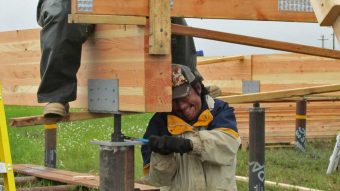Maintaining Your Crawlspace
Crawlspaces are an area of the house that tend to get neglected. The old adage “Out of sight out of mind” might apply here. Unfortunately, this also means that crawl space problems can go unnoticed until they have an effect on the living space above. At this point, a problem that could have been easily remedied may have progressed into an expensive structural or health-related issue. The crawlspace can also present a significant hidden energy drain on a home if not insulated properly.
Good moisture control is of primary concern in a crawlspace. This starts outside the building envelope, and many problems can be stopped here in their infancy. Gutters are a relatively inexpensive addition to a house that can provide huge preventative paybacks. In a climate with lots of rain, a house without gutters can direct lots of water against its foundation. Soils, wood and especially concrete are good conductors of water through capillary action. Picture a paper towel soaking up water—concrete works this way and can carry water great distances. If gutters are not an option, then at minimum the soils around the house should be sloped to direct water away from the building.
Once water reaches the foundation, things get a lot tougher. The structure must be prepared to resist infiltration. Ideally, both concrete and wood foundations should have some form of waterproofing on the outside. If this has deteriorated or was never installed, this may need to be remedied.
Assuming all external sources of moisture penetration have been addressed, the next step is to inspect the interior. With very few exceptions, exposed dirt floors should be covered and well sealed with a continuous vapor retarder such as polyethylene with a minimum 6 mil thickness. If the floor will receive traffic, then it may be necessary to use either thicker and/or reinforced polyethylene sheeting or an even more durable membrane such as EPDM rubber. Even a dirt floor that looks and feels “dry” can release significant amounts of moisture, especially after heavy rains.
Another important consideration is radon, a cancer-causing radioactive gas that occurs naturally in the earth. The University of Alaska Fairbanks Cooperative Extension Service (CES) advises that if you have never tested your crawlspace or basement, cold seasons are the best times to do so. The negative pressures created by combustion appliances, and stack effect in winter time, can bring radon into the home at a higher rate. Although high radon concentrations are considered hazardous, it’s possible that remediation after detection can be relatively simple. Testing crawlspaces is strongly recommended in areas known to have soils with radon concentrations. Test kits and information are available through the CES at 907-474-1530.
How well a crawlspace is insulated and sealed can affect the entire building envelope. In Fairbanks building codes require foundations to be a minimum of 42” below grade to protect the footings from freezing and frost jacking. Anything above that point could be at risk for freezing during the winter. This can mean serious heat losses if the crawl space is under-insulated. Inspect the foundation walls and floor system closely. If fiberglass insulation was set directly against the inside walls with no moisture protection, or the dirt floor was left exposed, it may be wet and need to be replaced. If the floor joists were insulated, the floor system should be looked at closely. Any exposed ducting should be inspected to make sure that all seams are sealed and connected. Be sure that exhaust fan piping (such as dryer ducting) doesn’t just terminate under the floor, but vents directly outside.
If you need to add or replace insulation, rigid foam and spray foam are good options. These types have high R-values and also qualify as vapor retarders. If you use foam, especially below-grade, make sure it’s approved by the manufacturer for your specific application. Spray foam and foam board may have certain restrictions or limitations in crawlspaces due to local fire codes. Some brands of foam insulation may meet fire code at a given thickness, while others may not. In addition, it may be possible to use either a coat of fire retardant paint, drywall, or fiberglass insulation to protect the foam board if required. The best source of information regarding current fire code considerations for foam insulations can be found at the local building department. Keep in mind that typically the local fire codes will need to be met if the home is put up for resale and is subject to inspection.
Summer is a good time to peek under the floor. The crawl space is integral to the foundation of the house, and in some cases the largest source of unregulated airflow into the home. It is not a good place to let moisture, poor air quality or bad insulation go unchecked.





